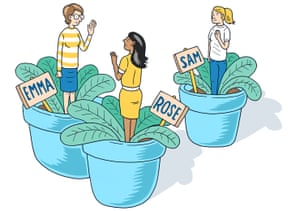How to win friends – and keep them
Emma Beddington has never mastered the art of friendship – so when she moved back to her hometown, she turned to science instead. But would it open doors?
Moving back to my childhood home town after 25 years has meant many things keep me awake at night. What have we done, will my sons start taking spice, why is York obsessed with bubble tea and Harry Potter, where did all these seagulls come from? One that recurs frequently, late at night, as the birds shriek outside my window is: will I make friends here?
We have just arrived after 12 years in Brussels and the past few weeks have been a whirl of call-centre absurdity and cardboard boxes. Soon, though, things will calm down, my 14- and 16-year-old boys will vanish, as teenagers do, my husband will return to Brussels for work and I will be home alone. My tally of local mates stands at one: my late mother’s 71-year-old best friend, to whom I have attached myself, limpet-like, revelling in a shared love of cake and gloomy chat.
I hesitate to admit this – it’s like saying you’re bad at sex – but I’m awful at friends and, aged 43, a friendship audit reflects badly on me. I do have a best friend, at least. We met online, which is how nearly all my recent friendships were made and are conducted. I could claim it’s circumstantial, but I fear it suits me. I can fade away from unpleasantness, step back when I’m irritable, give support without actually putting myself out greatly.
Apart from that, I have one friend from school, one work colleague-turned-friend who I last saw in 2009 and no parent friends from my sons’ infancies. I have no friends from my university days – I’m especially ashamed of this. I was unhappy and unwell at university, but I met brilliant, funny, kind people there who looked after me when things were bad and tolerated my self-indulgent despair. When we left, I was so relieved to escape and so keen to start a new phase in my life, I made no effort to keep in touch. I feel sick with shame now at my carelessness and ingratitude.
This pattern has repeated over the last 20 years. It’s not conscious, but I’m apparently compelled to shed the skin of the person I was in each place I leave and, by extension, anyone who ties me to it. It’s not that I think I can do better, more that I think I can be better. I had a reasonable social life in Brussels, but now I have slunk away, ready to perform my usual disappearing trick.
There’s a certain wrong-headed logic to my behaviour, according to Dr Sally Austen, a consultant clinical psychologist. “While old friends may link us to happy old memories, they also link us to the bad times. When we move it gives us a chance to ‘start again’, so if there’s a chance old friends will prevent our reinvention, it might feel safer to leave them behind.”
But it’s not as if I have any talent for making new friends; a tricky undertaking even for those more socially gifted than me. Recent researchfrom the University of Kansas gives an indication of how long it takes to forge friendship bonds: to move from acquaintance to casual friend takes approximately 50 hours of socialising and it takes 200 hours to cement a “close” friendship. If an average social event takes two hours, that’s 25 interactions to make a casual mate: far more if your preferred mode of interaction is a quick coffee. How, in adulthood, with families, work and partners, can we ever reach that threshold?
We should be investing time in friendship: that much is clear. The science on the damaging effects of social isolation (and the positive ones of connectedness) is persuasive. Loneliness increases the risk of high blood pressure and of heart disease and stroke and increases the likelihood of mortality by 26%. It’s unclear exactly why loneliness is so harmful, but it seems that immune responses are altered in those who perceive themselves as lonely.
Friendships also make us feel good, chemically: social touching produces oxytocin and social contact promotes endorphin release. We produce less cortisol in stressful situations when we are with a friend and can withstand discomfort for longer after socialising. If we’re willing to exercise, or eat healthily, shouldn’t we also commit to maintaining relationships that keep us well?
I’m making it sound like a joyless chore: eat your greens, see your friends. Of course it isn’t, but the 21st-century cliché that we’re relieved when plans are cancelled exists for a reason. Perhaps acknowledging that maintaining friendships takes work, but that work benefits us concretely, could shift my attitude?
Science can explain why I need friends, but can it also help me make some? I decided to try applying research findings to improve my friend tally.
Getting back in touch
Research from America showed that renewing contact with former friends can generate concrete social benefits and is, in the cold language of an academic paper abstract, “fairly efficient” (quick and easy) compared to making new ones. Back in my old home town, this is an obvious one for me to try, so I trawl Facebook looking for connections and, rigid with mortification, write a post asking if anyone local wants to meet up. My needy bleating gets me coffee invites from several old acquaintances (plus introductions to more friends of friends), so it’s worth it.
I would love to reconnect with my old university friend Claire who lives nearby, but Googling reveals she has become a judge since we last spoke, and further Googling reveals it’s impossible to find judges’ contact details online. I confess I’m hoping she’ll see this.
Even bin bags make friends
Social scientists have also shown that the more often you see someone, the more likeable you find them, even if they are not a person but a giant black bag. In the original 1968 researchon the topic, a person entirely swathed in a black bag joined a class; the other students’ attitudes evolved over time “from hostility to the Black Bag to curiosity and finally to friendship”.
I’ve made steps towards this by joining and regularly attending a co-working space and have already made one promising acquaintance. Poppy has amazing eyebrows and loves head scratches, yes, she is a miniature Schnauzer, but my hope is that I will eventually manage to leverage our relationship into some human ones. Being as appealing as a bin bag seems about my level, so I’m sticking at it.
Birds of a feather…
The classic advice on making friends – join a group doing something you enjoy – is backed by evidence that friends display similar preferences and personality traits, and by research this year demonstrating that friends have similar neural responses to a range of videos.
With this in mind, I hit Meetup (a site for groups of like-minded people to do stuff together), searching for platonic soulmates who share my interests in owl webcams and BBC’s Fake or Fortune presenter Philip Mould. The possibilities are varied and unnerving: there are groups for flat-earthers and Ayn Rand fans, but no owl voyeurs. Instead, I sign up to go and speak French and drink “du bon ale”. My husband is horrified, claiming “this is a sex thing” (possibly confusing it with French hook-up site Meetic).
He’s wrong: the vibe at my first meeting is more fleece and chips than unbridled sexual possibility. The inherent daftness of a group of English people speaking halting French together is a great icebreaker and I am soon ranting about slow-moving tourists en Français. I have a very satisfying conversation with a woman called Cathleen about the seagull menace and even find I have an acquaintance in common with someone (it’s Poppy the miniature Schnauzer). When I leave with a cheery “à la prochaine” I really mean it.
It takes two
The research finding that resonates with me most is a 2008 study that found that long-lasting friendships were those where both parties reciprocated contact. This is where I have failed in the past and where I am most determined to improve.
Of course I need human contact with people outside my family and that will mean forging new connections. But truthfully, I don’t feel I deserve new friends until I learn to look after the few I have. I ask Dr Austen for some advice on how to avoid repeating my mistakes. “Humans fail and two humans trying to build a relationship will fail more,” she says. “Trial and error; persistence and courage; the creation and taking of opportunities are all needed.”
Yes, friendships take time, work and kindness. But the handful I have are good for more than my health; they are good for my soul. An hour with a friend is pure oxygen, the relief of being seen and known and seeing and knowing in return. I cherish that, in my own clumsy, careless way, but now I’m determined to cherish it more actively and more carefully. If I were my friends, I’d be sourly sceptical about this miraculous conversion; thankfully, they’re far better friends than I am.



Comments
Post a Comment